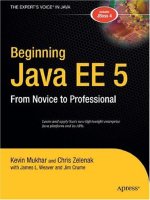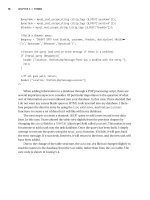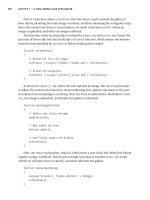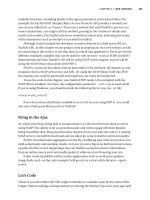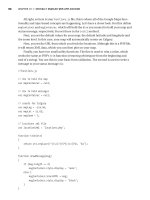Beginning Java EE 5 From Novice to Professional phần 3 docx
Bạn đang xem bản rút gọn của tài liệu. Xem và tải ngay bản đầy đủ của tài liệu tại đây (572.06 KB, 10 trang )
CHAPTER 1 ■ JAVA EE ESSENTIALS
19
As you’ll see in Chapter 9, building EJBs follows the same basic steps as creating an RMI
object. You create an interface that exposes the operations or services provided by the EJB. You
then create a class that implements the interface. When you deploy an EJB to an application
server, the EJB is associated with a name in a registry. Clients can look up the EJB in the registry,
and then remotely call the methods of the EJB. Since the EJB container provides all of the enter-
prise plumbing, you get to spend more time building your application and less time messing
around with trying to shoehorn in services like security and transaction support.
EJBs come in a few different flavors: session beans, entity beans, and message beans.
Session beans, as the name implies, live only as long as the conversation, or session, between
the client application and the bean lasts. The session bean’s primary reason for being is to
provide application services, defined and designed by the application developer, to client
applications. Depending on the design, a session bean may maintain state during the session
or may be stateless. With a stateful EJB, when a subsequent request comes from a client, the
values of the internal member variables have the same values they had when the previous
request ended, so that the EJB can maintain a conversation with the client. A stateless EJB
provides business rules through its exposed operations but doesn’t provide any sense of state;
that responsibility is delegated to the client.
Entity beans represent business objects—such as customers, invoices, and products—in
the application domain. These business objects are persisted so they can be stored and retrieved at
will. The Java EE architecture provides a lot of flexibility for the persistence model. You can
defer all of the work of storing and retrieving the bean’s state information to the container, as
shown in Figure 1-11. This is known as container-managed persistence.
Figure 1-11. In container-managed persistence, the EJB container is responsible for all actions
required to save the state of the EJB to some persistent store, usually a database.
Alternatively, the Java EE architecture allows you to have complete control over how the
EJB is persisted (which is very useful when you’re dealing with interfacing your Java EE system
to a legacy application!). This is known as bean-managed persistence and is illustrated in
Figure 1-12.
Mukhar_470-3.book Page 19 Saturday, October 1, 2005 6:14 AM
20
CHAPTER 1
■ JAVA EE ESSENTIALS
Figure 1-12. With bean-managed persistence, the developer must manage all aspects of persisting
the state of the EJB.
The third type of EJB, the message bean, provides a component model for services that
listen to Message Service messages, as illustrated in Figure 1-13. The Java EE platform includes
a message queue that allows applications to post messages to a queue, as well as to subscribe to
queues that get messages. The advantage of this particular way of doing things is that the
sender and the receiver of the message don’t need to know anything about each other. They
need to know only about the message queue itself. This differs from a client/server model,
where a client must know the server so that it can make a connection and a specific request,
and the server sends the response directly to the client. One example of using a message queue
is an automated stock trading system. Stock prices are sent as messages to a message queue,
and components that are interested in stock prices consume those messages. With message-
driven EJBs, it is possible to create an EJB that responds to messages concerning stock prices
and makes automatic trading decisions based on those messages.
Figure 1-13. A message queue allows senders and receivers of messages to remain unaware of each
other. Senders of messages can send the message to a queue, knowing that something will get the
message, but not knowing exactly what receives the message or when it will be received. Receivers
can subscribe to queues and get the messages they are interested in, without needing to know
who sent the message.
Mukhar_470-3.book Page 20 Saturday, October 1, 2005 6:14 AM
CHAPTER 1 ■ JAVA EE ESSENTIALS
21
You will learn a lot about the ins and outs of using session and entity beans in Chapters 9
through 12. Your Java EE applications will typically be comprised of both session and entity
beans. Message beans are covered in Chapter 14. They’re not used as frequently as the other
flavors in most applications, but they’re still pretty darn cool!
XML Support
Extensible Markup Language (XML) is a significant cornerstone for building enterprise systems
that provide interoperability and are resilient in the face of changes. There are several key tech-
nologies in Java EE that rely on XML for configuration and integration with other services.
Java EE provides a number of APIs for developers working with XML. Java API for XML
Processing (JAXP) provides support for generating and parsing XML with both the Document
Object Model (DOM), which is a tree-oriented model, and the Simple API for XML (SAX), which
is a stream-based, event-driven processing model.
The Java API for XML Binding (JAXB) provides support for mapping XML to and from Java
classes. It provides a compiler and a framework for performing the mapping, so you don’t need
to write custom code to perform those transformations.
The Java API for XML Registries (JAXR), Java API for XML Messaging (JAXM), and Java API
for XML-based Remote Procedure Calls (JAX-RPC) round out the XML API provisions. These
sets of APIs provide support for SOAP and web services (discussed in the following section).
This book assumes that you are familiar with XML basics. If you need a refresher on XML, you
might want to review the Sun Java XML tutorial at />Web Services
The World Wide Web is becoming an increasingly prevalent backbone of business applications.
The endpoints that provide web applications with server-side business rules are considered
web services. The World Wide Web Consortium (W3C), in an effort to unify how web services
are published, discovered, and accessed, has sought to provide more concrete definitions for
web services. Here’s a definition from the Web Services Architecture, Working Group Note 11
(www.w3.org/TR/ws-arch):
A Web service is a software system designed to support interoperable machine-
to-machine interaction over a network. It has an interface described in a
machine-processable format (specifically WSDL). Other systems interact with
the Web service in a manner prescribed by its description using SOAP
messages, typically conveyed using HTTP with an XML serialization in
conjunction with other Web-related standards.
This definition contains some specific requirements:
• A web service allows one computer to request some service from another machine.
• Service descriptions are machine-processible.
• Systems access a service using XML messages sent over HTTP.
Mukhar_470-3.book Page 21 Saturday, October 1, 2005 6:14 AM
22
CHAPTER 1
■ JAVA EE ESSENTIALS
The W3C has established the Web Service Description Language (WSDL) as the XML format
that is used by web services to describe their services and how clients access those services. In
order to call those services, clients need to be able to get their hands on those definitions. XML
registries provide the ability to publish service descriptions, search for services, and obtain the
WSDL information describing the specifics of a given service.
There are a number of overlapping XML registry service specifications, including ebXML
and Universal Description, Discovery, and Integration (UDDI). The JAXR API provides an
implementation-independent API for accessing those XML registries.
Simple Object Access Protocol (SOAP) is the lingua franca used by web services and their
clients for invocation, parameter passing, and obtaining results. SOAP defines the XML message
standards and data mapping required for a client application to call a web service and pass it
parameters. The JAX-RPC API provides an easy-to-use developer interface that masks the
complex underlying plumbing.
Not surprisingly, the Java EE architecture provides a container that hosts web services,
and a component model for easily deploying web services. Chapters 15 and 16 in this book
cover SOAP and web services.
Transaction Support
One of the basic requirements of enterprise applications is the ability to allow multiple users of
multiple applications to simultaneously access shared databases and to absolutely ensure the
integrity of that data across those systems. Maintaining data consistency is no simple thing.
Suppose that your application was responsible for processing bank deposits, transfers,
and withdrawals. Your application is processing a transfer request from one account to another.
That process seems pretty straightforward: deduct the requested amount from one account
and add that same amount to the other account. Suppose, however, that immediately after
deducting the sum from the source account, something went horribly wrong—perhaps a server
failed or a network link was severed—and it became impossible to add the transfer to the target
account. At that point, the data’s integrity has been compromised (and worse yet, someone’s
money is now missing).
Transactions can help to address this sort of problem. A transaction represents a set of
activities that collectively will either succeed and be made permanent, or fail and be discarded.
In the situation of a bank account transfer, you could define the transaction boundaries to start
as the transfer amount is withdrawn from the source account, and end after the target account
is updated successfully. When the transaction had been made successfully, the changes are
committed. Any failure inside the transaction boundary would result in the changes being
rolled back and the account balances restored back to the original values that existed before
the start of the transaction.
Java EE—and the EJB in particular—provides substantial transaction support. The EJB
container provides built-in support for managing transactions, and allows the developer to
specify and modify transaction boundaries without changing code. Where more complex
transaction control is required, the EJB can take over the transaction control from the container
and perform fine-grained or highly customized transaction handling.
Mukhar_470-3.book Page 22 Saturday, October 1, 2005 6:14 AM
CHAPTER 1 ■ JAVA EE ESSENTIALS
23
You’ll find an introduction to transactions, in the context of database transactions with
JDBC, in Chapter 8.
Security
Security is a vital component in enterprise applications, and Java EE provides built-in security
mechanisms that are far more secure than homegrown security solutions that are typically
added as an afterthought.
Java EE allows application resources to be configured for anonymous access where security
isn’t a concern. Where there are system resources that need to be secured, however, it provides
authentication (making sure your users really are who they say they are) and authorization
(matching up users with the privileges they are granted).
Authorization in Java EE is based on roles of users of applications. You can classify the
roles of users who will be using your application, and authorize access to application compo-
nents based on those roles. Java EE provides support for declarative security that is specified
when the application is deployed, as well as programmatic security that allows you to build
fine-grained security into the Java code.
■Note If you’re interested in learning more about Java EE-specific security, refer to a book devoted to Java
security. One such book is Hacking Exposed J2EE & Java, by Art Taylor, Brian Buege, and Randy Layman
(Osborne/McGraw Hill, 2002; ISBN 0-07-222565-3).
Sample Java EE Architectures
There is no such thing as a single software architecture that fits all applications, but there are
some common architectural patterns that reappear frequently enough to merit attention.
As we explained earlier in the chapter, Java EE provides a platform that enables developers
to easily create n-tier (multitier) applications in a number of different configurations. The basic
n-tier architecture can have any number of components in each tier, and any combination
between tiers.
Here, we will briefly review some architectures that you’re likely to run into as you examine
and develop Java EE-based systems. Each one of these has its own merits and strong points. We
present them here to illustrate that there are a number of ways to put together applications and
as a short “field guide” for identifying these architectures as you spot them in the wild.
Application Client with EJB
Figure 1-14 shows an architecture where an application client composes the presentation tier
and communicates with an EJB in the business tier.
The client application is built as a stand-alone (JFC/Swing or console) application. The
application relies on business rules implemented as EJBs running on a separate machine.
Mukhar_470-3.book Page 23 Saturday, October 1, 2005 6:14 AM
24
CHAPTER 1
■ JAVA EE ESSENTIALS
Figure 1-14. An application client can be implemented as a normal Java application based on
Swing or AWT, or even as a console application. The client communicates with EJBs in the
business tier.
JSP Client with EJB
Figure 1-15 shows an architecture based on JSPs. JSPs on the server interface with the business
layer in response to requests. The response is generated as a web page, which is sent to the
client’s web browser.
Figure 1-15. In this architecture, the application client is a web page in a browser. The web page is
generated by a JSP that communicates with the business layer.
Mukhar_470-3.book Page 24 Saturday, October 1, 2005 6:14 AM
CHAPTER 1 ■ JAVA EE ESSENTIALS
25
The client in this architecture is a web browser. JSPs access business rules and generate
content for the browser.
Applet Client with JSP and Database
Figure 1-16 shows an architecture similar to the one shown in Figure 1-15. In this case, the
client is a Java applet that resides entirely in the presentation tier and communicates with the
business layer. Although the business layer could be an EJB, as in the previous example, in this
example, the business layer is constructed from JSPs.
Figure 1-16. An applet in the presentation layer can communicate over the network with JSPs
(or Servlets) in the business layer.
The Java applet is used within a web page to provide a more interactive, dynamic user
interface for the user. That applet accesses additional content from JSPs. Even though JSPs are
normally used to generate HTML web pages, a JSP could consist of only business logic. The
JSPs access data from a database using the JDBC API.
Web Services for Application Integration
Even though Java EE is Java-based, a web application architecture is not limited solely to Java
components. An obvious example is the data tier, where many enterprise-level databases are
implemented in a high-level language such as C or C++. Similarly, components in a tier can be
implemented in languages other than Java, as long as they provide a well-defined interface that
allows for interprocess communication. In the example shown in Figure 1-17, a client applica-
tion implemented in C# accesses data from a web service implemented in Java.
Mukhar_470-3.book Page 25 Saturday, October 1, 2005 6:14 AM
26
CHAPTER 1
■ JAVA EE ESSENTIALS
Figure 1-17. The web service interface provides a well-defined interface between clients and web
services. It allows clients to be implemented in any language that supports making HTTP
requests to a server. For example, clients written in C# can format a web service request, which
can be serviced by an EJB written in Java and running in a Java EE application server.
Summary
In this opening chapter, we provided an overview of Java EE and how all the various bits fit
together to enable you to create powerful business components. We first looked at what Java EE is
and tackled the obvious issue of moving from creating desktop applications with J2SE to
building enterprise-level applications and dynamic, data-driven web sites using Java EE. We
covered how the two relate to each other and how they differ from each other, as well as looking
at how applications are built using Java EE.
Java EE provides a platform for developing and deploying multitiered, distributed applications
that are designed to be maintainable, scalable, and portable. Just as an office building requires
a lot of hidden infrastructure of plumbing, electricity, and telecommunications, large-scale
applications require a great deal of support infrastructure. This infrastructure includes database
access, transaction support, and security. Java EE provides that infrastructure and allows you
to focus on your applications.
Building distributed applications (software with components that run as separate processes,
or on separate computers) allows you to partition the software into layers of responsibility, or
tiers. Distributed applications are commonly partitioned into three primary tiers: presentation,
business rules, and data access. Partitioning applications into distinct tiers makes the software
more maintainable and provides opportunities for scaling up applications as the demand on
those applications increases.
Java EE architecture is based on the idea of building applications around multiple tiers of
responsibility. The application developer creates components, which are hosted by the Java EE
containers. Containers play a central theme in the Java EE architecture.
Servlets are one type of Java EE web component. They are Java classes that are hosted
within, and invoked by the Java EE server by requests made to, a web server. These Servlets
respond to those requests by dynamically generating HTML, which is then returned to the
requesting client.
Mukhar_470-3.book Page 26 Saturday, October 1, 2005 6:14 AM
CHAPTER 1 ■ JAVA EE ESSENTIALS
27
JSPs are very similar in concept to Servlets, but differ in that the Java code is embedded
within an HTML document. The Java EE server then compiles that HTML document into a
Servlet, and that Servlet generates HTML in response to client requests.
JSF is a Java EE technology designed to create full and rich user interfaces. Standard user
interface components are created on the server and connected to business logic components.
Custom renderers take the components and create the actual user interface.
JDBC is a technology that enables an application to communicate with a data-storage
system. Most often that is a relational database that stores data in tables that are linked through
logical relations between tables. JDBC provides a common interface that allows you to communi-
cate with the database through a standard interface without needing to learn the syntax of a
particular database.
EJBs are the centerpiece of Java EE and are the component model for building the business
rules logic in a Java EE application. EJBs can be designed to maintain state during a conversation
with a client, or can be stateless. They can also be designed to be short-lived and ephemeral, or
can be persisted for later recall. EJBs can also be designed to listen to message queues and
respond to specific messages. Java EE is about a lot more than EJBs, although EJBs do play a
prominent role.
The Java EE platform provides a number of services beyond the component hosting of
Servlets, JSPs, and EJBs. Fundamental services include support for XML, web services, transac-
tions, and security.
Extensive support for XML is a core component of Java EE. Support for both document-based
and stream-based parsing of XML documents forms the foundation of XML support. Additional
APIs provide XML registry service, remote procedure call invocation via XML, and XML-based
messaging support.
Web services, which rely heavily on XML, provide support for describing, registering,
finding, and invoking object services over the Web. Java EE provides support for publishing
and accessing Java EE components as web services.
Transaction support is required in order to ensure data integrity for distributed database
systems. This allows complex, multiple-step updates to databases to be treated as a single step
with provisions to make the entire process committed upon success, or completely undone by
rolling back on a failure. Java EE provides intrinsic support for distributed database transactions.
Java EE provides configurable security to ensure that sensitive systems are afforded appro-
priate protection. Security is provided in the form of authentication and authorization.
After reading this chapter, you should know:
• Containers provide an environment and infrastructure for executing Java EE components.
• Servlets and JSPs provide server-side processing and are used to create the presentation
layer of a Java EE system.
• JSF provides user interface components that make it easy to create flexible user interfaces
and connect user interface widgets to business objects.
• JDBC is an interface to database systems that allows developers to easily read and persist
business data.
• EJBs represent business objects in a Java EE application. EJBs come in various categories,
including stateful session beans, stateless session beans, entity beans, and message-
driven beans.
Mukhar_470-3.book Page 27 Saturday, October 1, 2005 6:14 AM
28
CHAPTER 1
■ JAVA EE ESSENTIALS
• Java EE systems can be used to develop service-oriented architectures or web services
systems. A web service architecture is one that provides machine-to-machine services
over a network using a well-defined protocol.
• Some of the essential architectural patterns used in Java EE applications include an
application client with EJBs, a JSP client with EJBs, an applet client with JSPs and a data-
base, and web services used for application integration.
That’s it for your first taste of how Java EE works and why it is so popular. In the next chapter,
you’ll see the steps required to set up your environment and make it ready for developing
powerful Java EE applications.
Mukhar_470-3.book Page 28 Saturday, October 1, 2005 6:14 AM
